Special tool
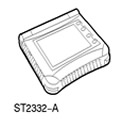 | World Diagnostic System (WDS) 418-F224 |
General equipment: Pneumatic vacuum gun.
| Name | Specification |
| Lubricant for the nipple connection of the high pressure fuel supply line |
Withdrawal
All cars
WARNING: Do not smoke or walk with a lit cigarette or any type of open flame while working on or near fuel related items. In such situations, there are always highly flammable mixtures that can ignite. Failure to follow these instructions may result in injury.
WARNING: This procedure is related to fuel handling. Always be aware of the possibility of fuel splashing and observe fuel handling precautions. Failure to follow these instructions may result in injury.
WARNING: Do not make any repairs to the fuel injection system while the engine is running. The fuel pressure in the system can reach 1600 bar. Failure to follow these instructions may result in injury.
WARNING: Do not make any repairs to the fuel injection system without checking that the fuel pressure has dropped to zero and the fuel temperature has reached the outside temperature or below 30°C, whichever is greater. Failure to follow these instructions may result in injury.
WARNING: After stopping the engine, wait at least one minute before making any repairs to the fuel injection system. Failure to follow these instructions may result in injury.
WARNING: Make sure that the workshop area where the vehicle is being worked on is as clean and dust free as possible. Foreign matter from work on the clutch, brakes, or machining or welding operations can contaminate the fuel system and result in subsequent malfunction.
CAUTION: Always perform the cleaning procedure before making any repairs to the fuel injection system components. Failure to follow this instruction may result in dirt entering the fuel injection system.
CAUTION: Diesel fuel injection equipment is manufactured to very precise tolerances and very close clearances. Therefore, it is especially important to observe absolute cleanliness when working with these elements. Open holes or lines should always be plugged with appropriate plugs.
CAUTION: Do not disassemble fuel injectors or clean their nozzles, even with ultrasonication. Always install new fuel injectors if necessary.
1. Using the function «Data logger» («Datalogger») world diagnostic system (WDS), check that the fuel pressure has dropped to zero and the fuel temperature has reached the outside temperature or a temperature below 30°C, whichever is greater.
2. Disconnect a wire of weight from the accumulator. See Section 414-01 for more information.
3. Remove the engine top cover.
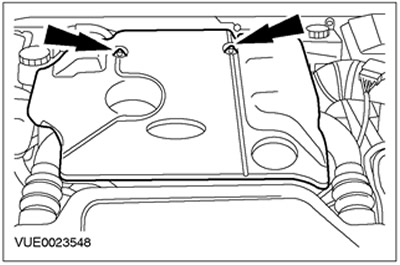
4. Remove the air baffle.

5. Disconnect the charge air cooler inlet pipe.

Vehicles with a 100 HP diesel engine
6. Disconnect the charge air cooler outlet pipe. Disconnect the vacuum line from the charge air cooler outlet pipe.
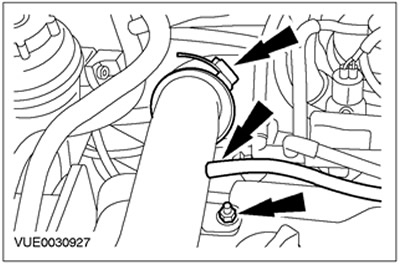
Vehicles with a 115 hp diesel engine
7. Disconnect the charge air cooler outlet pipe.

All cars
8. Disconnect the plug connector of the air intake temperature sensor (IAT) and remove the charge air cooler and piping.

9.
CAUTION: Protect generator from contamination. Failure to follow this instruction may result in premature generator failure.
Cover the generator with lint-free material to prevent contamination.
10.
CAUTION: Cover fuel injector plugs with lint-free material to prevent contamination with cleaning fluid.
Clean the fuel injector, high pressure fuel supply line and adjacent areas. For more information, refer to the chapter Cleaning the fuel injection system components found in this section.
11.
CAUTION: Do not allow engine oil to drip from the hose or valve cover onto the injector or high pressure fuel feed line.
Disconnect the crankcase breather hose (PCV) (this action is only required if the No. 4 fuel injector is removed).
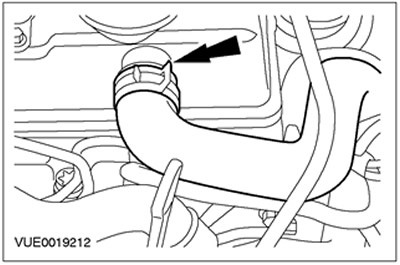
12. Disconnect the fuel return line from the fuel injector. Install a plug in the return port of the fuel injector.

13. Disconnect the fuel injector connector.
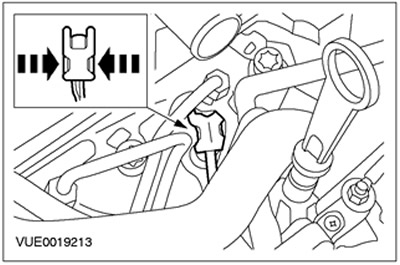
14.
NOTE: Mark the orientation of the clip to ensure it is installed in exactly the same position.
Remove the high pressure fuel line clamp.

15.
CAUTION: Make sure the high pressure fuel supply line remains in contact with the fuel injector and fuel manifold until both pin connections are disconnected and cleaned. Failure to follow this instruction may result in dirt entering the fuel injection system.
CAUTION: The high pressure fuel supply nipple release tool should be installed at the top of the connection as this is where most of the material is found. Failure to follow this instruction may result in damage to the pin connections.
Disconnect the high pressure fuel supply line from the fuel injector.

16.
CAUTION: Make sure the high pressure fuel supply line remains in contact with the fuel injector and fuel manifold until both pin connections are disconnected and cleaned. Failure to follow this instruction may result in dirt entering the fuel injection system.
CAUTION: The high pressure fuel supply nipple release tool should be installed at the top of the connection as this is where most of the material is found. Failure to follow this instruction may result in damage to the pin connections.
Disconnect the high pressure fuel supply line from the fuel manifold.

17.
CAUTION: Make sure the high pressure fuel supply line remains in contact with the fuel injector and fuel manifold until both pin connections are disconnected and cleaned. Failure to follow this instruction may result in dirt entering the fuel injection system.
Using a pneumatic vacuum gun, remove foreign material from the high pressure fuel supply line, fuel injector and fuel manifold.
18. Remove the high pressure fuel supply line and discard it as no longer needed.
19. Using a pneumatic vacuum gun, remove foreign material from the fuel injector and fuel manifold.
20. Install plugs in the exposed threaded holes of the fuel injector and fuel manifold.
21. Turn out a bolt of fastening of a clip of a fuel atomizer. Discard the bolt as it is no longer needed.

22. Clean the area around the fuel injector. For more information, refer to the chapter Cleaning the fuel injection system components found in this section.
23. Remove the fuel injector and clip. Discard the fuel injector sealing washer as it is no longer needed.
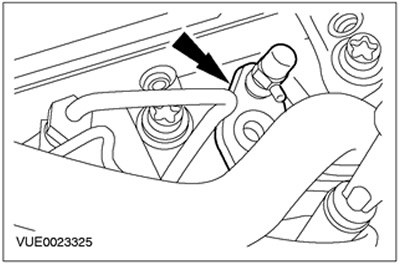
Installation
All cars
WARNING: Do not smoke or allow a lit cigarette or open flame of any kind to be present when working on or near fuel related items. In such situations, there are always highly flammable mixtures that can ignite. Failure to follow these instructions may result in injury.
WARNING: This procedure is related to fuel handling. Always be aware of the possibility of fuel splashing and observe fuel handling precautions. Failure to follow these instructions may result in injury.
WARNING: Make sure that the workshop area where the vehicle is being worked on is as clean and dust free as possible. Foreign matter from work on the clutch, brakes, or machining or welding operations can contaminate the fuel system and result in subsequent malfunction.
CAUTION: Always perform the cleaning procedure before making any repairs to the fuel injection system components. Failure to follow this instruction may result in dirt entering the fuel injection system.
CAUTION: Diesel fuel injection equipment is manufactured to very precise tolerances and very close clearances. Therefore, it is especially important to observe absolute cleanliness when working with these elements. Open holes or lines should always be plugged with appropriate plugs.
CAUTION: Do not disassemble fuel injectors or clean their nozzles, even with ultrasonication. Always install new fuel injectors if necessary.
NOTE: Install a new fuel injector sealing washer.
NOTE: Install a new fuel injector clamp bolt.
NOTE: Install a new high pressure fuel supply line.
1. Write down the identification code of the new fuel injector to upload it to WDS when setting up the configuration (the figure shows the identification code as an example only).

2. Install a new fuel injector sealing washer into the fuel injector recess in the cylinder head.
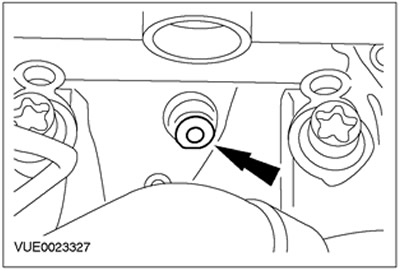
3. Remove the plug from the fuel injector nozzle and install the fuel injector and clamp. Discard the plug as it is no longer needed.

4. Install a new fuel injector clamp bolt.

5. Lubricate the threads of the nipple connections of the high pressure fuel supply lines with a clean lubricant.

6.
CAUTION: Protect generator from contamination. Failure to follow this instruction may result in premature generator failure.
Cover the generator with lint-free material to prevent contamination.
7.
CAUTION: Do not strike the ends of the high pressure fuel supply line. Failure to follow this instruction may result in damage to the ends of the fuel line and the entry of foreign material into the fuel injection system.
CAUTION: Remove the plugs from the high pressure fuel supply line, fuel injector and fuel manifold as soon as possible. Failure to follow this instruction may result in dirt entering the fuel injection system.
NOTE: For easy identification of the high pressure fuel feed lines, the fuel injector side connections are engraved with the cylinder number.
NOTE: Do not tighten the high pressure fuel feed nipple connections at this stage.
NOTE: Apply pressure to the high pressure fuel supply line to keep the fuel line nipple in contact with the fuel injector cone when connected.
NOTE: If it is not possible to properly install the new high pressure fuel feed line, the remaining high pressure fuel feed lines must be removed and the fuel manifold loosened to ensure correct alignment. For more information, refer to the Fuel manifold chapter available in this section.
Install a new high pressure fuel supply line.
- 1. Connect the high pressure fuel supply line to the fuel manifold.
- 2. Connect the high pressure fuel supply line to the fuel injector.
- Discard plugs as they are no longer needed.

8.
NOTE: Be sure to install the clip in the same position it was in before removal.
Install the high pressure fuel line clamp.

9.
CAUTION: The high pressure fuel supply nipple tightening tool should be installed at the top of the connection as this is where most of the material is found. Failure to follow this instruction may result in damage to the pin connection.
Tighten the nipple connection of the high pressure fuel supply line on the fuel injector.

10.
CAUTION: The high pressure fuel supply nipple tightening tool should be installed at the top of the connection as this is where most of the material is found. Failure to follow this instruction may result in damage to the pin connection.
Tighten the nipple connection of the high pressure fuel supply line on the fuel manifold.

11. Remove the plug from the fuel injector return port and connect the fuel injector return line. Discard the plug as it is no longer needed.

12. Connect the fuel injector connector.

13. Connect the positive crankcase ventilation hose (PCV) (this action is only required if the No. 4 fuel injector is removed).

14. Remove lint-free material from the generator.
15. Install the charge air cooler and piping and dock the IAT sensor connector.
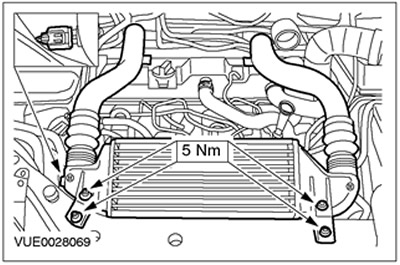
Vehicles with a 115 hp diesel engine
16.
CAUTION: Make sure the inside of the end of the charge air cooler exhaust pipe is clean and free of oil, as this reduces the friction when connecting the piping to the charge air cooler. Failure to follow this instruction may result in engine damage.
Connect the charge air cooler outlet pipe.

Vehicles with a 100 HP diesel engine
17.
CAUTION: Make sure the inside of the end of the charge air cooler exhaust pipe is clean and free of oil, as this reduces the friction when connecting the piping to the charge air cooler. Failure to follow this instruction may result in engine damage.
Connect the exhaust pipe to the charge air cooler. Connect the vacuum line to the charge air cooler outlet pipe.

All cars
18.
CAUTION: Make sure the inside of the charge air cooler intake pipe is clean and free from oil, as this impairs the adhesion between the piping and the charge air cooler. Failure to follow this instruction may result in engine damage.
Connect the charge air cooler intake pipe.

19. Install the air deflector.
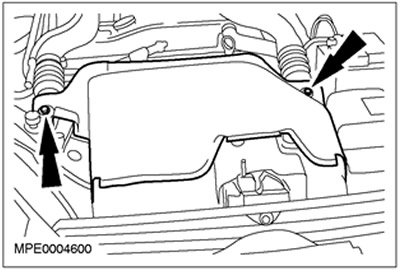
20. Install the engine top cover.

21. Connect a wire of weight to the accumulator. See Section 414-01 for more information.
22. Using WDS, configure the new fuel injector with respect to the injector control module.
Visitor comments